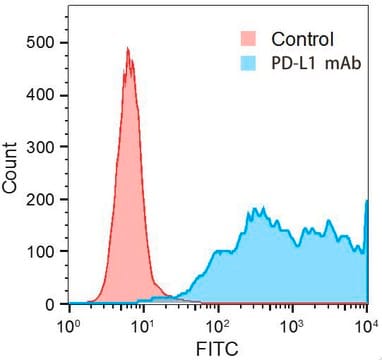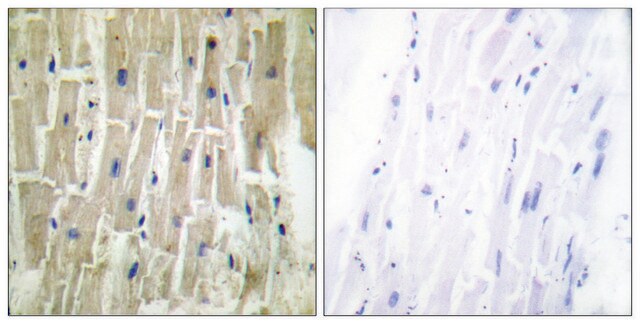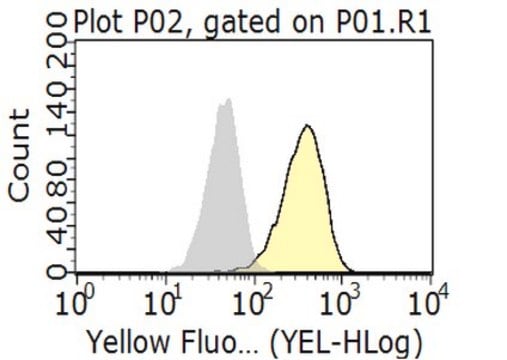一般說明
We are committed to bringing you greener alternative products, which adhere to one or more of the 12 Principles of Green Chemistry. This antibody is preservative-free, produced without the harm or sacrifice of animals and exceptionally stable to allow for ambient shipping and storage if needed, and thus aligns with "Waste Prevention", "Designing Safer Chemicals" and "Design for Energy Efficiency".
Click here for more information.
ZooMAb® antibodies represent an entirely new generation of recombinant monoclonal antibodies. Each ZooMAb® antibody is manufactured using our proprietary recombinant expression system, purified to homogeneity, and precisely dispensed to produce robust and highly reproducible lot-to-lot consistency. Only top-performing clones are released for use by researchers. Each antibody is validated for high specificity and affinity across multiple applications, including its most commonly used application. ZooMAb® antibodies are reliably available and ready to ship when you need them.
特異性
Clone 73-10 is a ZooMAb® rabbit recombinant monoclonal antibody that specifically detects Programmed cell death 1 ligand 1 (PD-L1/CD274). It targets an epitope within the C-terminal region.
免疫原
KLH-conjugated linear peptide from the C-terminal region of human PD-L1.
應用
Quality Control Testing
Evaluated by Western Blotting in MDA-MB-231 cell lysate.
Western Blotting Analysis: A 1:1,000 dilution of this antibody detected PD-L1/CD274 in MDA-MB-231 cell lysate.
Tested Applications
Flow Cytometry Analysis: 1 µg from a representative lot detected PD-L1/CD274 in one million MDA-MB-231 cells.
Immunocytochemistry Analysis: A 1:100 dilution from a representative lot detected PD-L1/CD274 in MDA-MB-231 cells.
Immunohistochemistry (Paraffin) Analysis: A 1:100 dilution from a representative lot detected PD-L1/CD274 in Human placenta, Human tonsil, Human thymus, Human small cell lung cancer and Human large cell lung cancer tissue sections.
Note: Actual optimal working dilutions must be determined by end user as specimens, and experimental conditions may vary with the end user.
標靶描述
Programmed cell death 1 ligand 1 (UniProt: Q9NZQ7; also known as PD-L1, PDCD1 ligand 1, Programmed death ligand 1, hPD-L1, B7 homolog 1, B7-H1, CD274) is encoded by the CD274 (also known as B7H1, PDCD1L1, PDCD1LG1, PDL1) gene (Gene ID: 29126) in human. PD-L1 is a single-pass type I membrane glycoprotein that plays a critical role in induction and maintenance of immune tolerance to self. It is expressed on activated T- and B-cells, dendritic cells, keratinocytes, and monocytes. Higher expression has also been reported in heart, skeletal muscle, placenta, and lung. . It is synthesized with a signal peptide (aa 1-18), which is subsequently cleaved off to produce the mature protein that contains a large extracellular domain (aa 19-238), a transmembrane domain (aa 239-259), and a cytoplasmic tail (aa 260-290). The extracellular region contains an Ig-like V-type domain (aa 19-127) and an Ig-like C2-type domain (aa 133-225). PD-L1 is expressed on activated T- and B-cells, dendritic cells, keratinocytes, and monocytes. Higher expression has also been reported in heart, skeletal muscle, placenta, and lung. It plays a critical role in induction and maintenance of immune tolerance to self. When engaged together with the TCR, the interaction of PD-1 with its ligands, PD-L1 and PD-L2, deliver an inhibitory signal to T cell proliferation and cytokine production. While PD-L1 is broadly expressed in hematopoietic and nonhematopoietic cells, PD-L2 expression is highly restricted to antigen presenting cells (APCs), including dendritic cells (DCs) and macrophages. The PD-1 pathway plays a key role in the progressive loss of effector T cell responses during chronic HIV infection. Cancer cells are reported to express higher levels of PD-L1 to subvert T-cell-mediated immunosurveillance. Under some conditions, blockade of this pathway can restore many T cell functions. This ZooMAb® recombinant monoclonal antibody, generated by our propriety technology, offers significantly enhanced specificity, affinity, reproducibility, and stability over conventional monoclonals. (Ref.: Freeman, GJ., et al. (2000). J. Exp. Med. 192(7); 1027-1034; Burr, ML., et al. (2017). Nature. 549(7670); 101-105).
外觀
Purified recombinant rabbit monoclonal antibody IgG, lyophilized in PBS with 5% Trehalose, normal appearance a coarse or translucent resin. The PBS/trehalose components in the ZooMAb formulation can have the appearance of a semi-solid (bead like gel) after lyophilization. This is a normal phenomenon. Please follow the recommended reconstitution procedure in the data sheet to dissolve the semi-solid, bead-like, gel-appearing material. The resulting antibody solution is completely stable and functional as proven by full functional testing. Contains no biocide or preservatives, such as azide, or any animal by-products. Larger pack sizes provided as multiples of 25 µL.
重構
30 µg/mL after reconstitution at 25 µL per vial. Please refer to guidance on suggested starting dilutions and/or titers per application and sample type.
儲存和穩定性
Recommend storage of lyophilized product at 2-8°C; Before reconstitution, micro-centrifuge vials briefly to spin down material to bottom of the vial; Reconstitute each vial by adding 25 µL of filtered lab grade water or PBS; Reconstituted antibodies can be stored at 2-8°C, or -20°C for long term storage. Avoid repeated freeze-thaws.
法律資訊
ZooMAb is a registered trademark of Merck KGaA, Darmstadt, Germany
免責聲明
Unless otherwise stated in our catalog or other company documentation accompanying the product(s), our products are intended for research use only and are not to be used for any other purpose, which includes but is not limited to, unauthorized commercial uses, in vitro diagnostic uses, ex vivo or in vivo therapeutic uses or any type of consumption or application to humans or animals.









